| |
FAIRYWRENS & GRASSWRENS Maluridae |
- 32 species in Australasia
- DR personal total: 17 species (53%), 8 photo'd
|
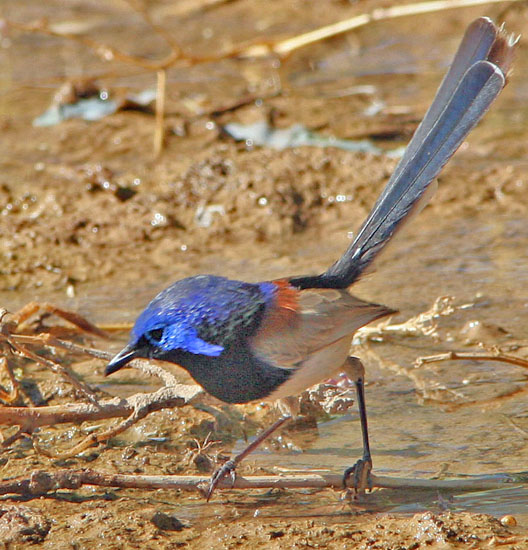 The Maluridae is an Australasian family comprised of 16 fairywrens, three emu-wrens, and 13 grasswrens. Each of of them is an absolutely fabulous little bird. They are generally active, cock-tailed, territorial, non-migratory foliage-gleaning "wrens;" many have brilliant plumage patterns. [They are not closely related to Holarctic wrens at all]. Six species are malurids are found only in New Guinea and adjacent islands, but 26 are restricted to Australia. The family is named after the fairywren genus Malurus, and fairywrens are the most colorful group in the family. The Maluridae is an Australasian family comprised of 16 fairywrens, three emu-wrens, and 13 grasswrens. Each of of them is an absolutely fabulous little bird. They are generally active, cock-tailed, territorial, non-migratory foliage-gleaning "wrens;" many have brilliant plumage patterns. [They are not closely related to Holarctic wrens at all]. Six species are malurids are found only in New Guinea and adjacent islands, but 26 are restricted to Australia. The family is named after the fairywren genus Malurus, and fairywrens are the most colorful group in the family.
All of the Malurus fairywrens are dramatically sexually dimorphic, with bright, colorful males and rather plain, inconspicuous females and young. A widespread species, occurring throughout the interior of Australia, is Purple-backed Fairywren. The dominant male can be stunning (left). Females and young are gray with bluish tails, although in some populations females also have bluish upperparts.
White-winged Fairywren (below, male shown) is an arid-country species in low bushes, shown here from near Alice Springs in the "red centre" of the continent. Males of the continental form are dramatically blue-and-white, while populations on a couple of small islands off western Australia are black-and-white, and might involve new species. |
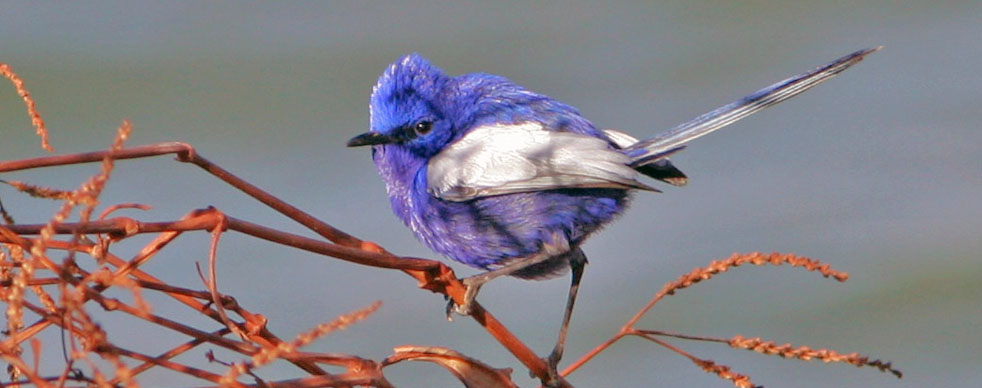 |
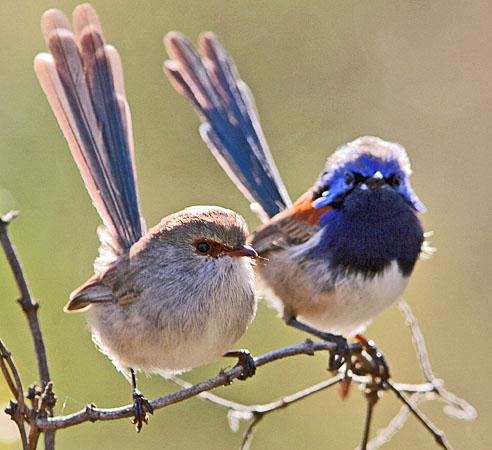 Strong sexual dimorphism is a common feature among the Malurus fairywrens, such as Blue-breasted Fairywren (right; female & male together). This is a species of southwest and southern Australia, living in the understory of eucalypt woodland or adjacent heath. Strong sexual dimorphism is a common feature among the Malurus fairywrens, such as Blue-breasted Fairywren (right; female & male together). This is a species of southwest and southern Australia, living in the understory of eucalypt woodland or adjacent heath.
The fairywrens' overall lifestyle was summarized in the grandest family book every published (in my opinion): Schodde's (1982) The Fairy-Wrens: A Monograph of the Maluridae [review at bottom of this page]. Using a very common eastern species as an example, Schodde wrote:
"Few Australian birds are as familiar as the Superb Fairy-wren (Malurus cyaneus), and none so delightfully confiding and full of zest... The astonishing sight of a male in full nuptial regalia escorting four or five brown birds led to a widespread belief that he was polygamous and kept a 'harem' of females. Some even called him the 'Mormon bird.' Sensitive to social convention, naturalists who had come to love and admire his pert cheekiness were suddenly caught with having to defend his honour. This they stoutly upheld, filling much of the ornithological literature with justifications of his valour in protecting territory and of his attentiveness to his brood."
Ironically, all this energy in early times "to defend his honour" was entirely unnecessary. In 1965, Ian Rowley completed a study of the life history of Superb Fairywren based on observations of banded birds of known age and sex. Family groups were not males with a harem of females — rather, each pack had just one female mated to the dominant male, and the rest were young males who were kin. These young males remain in drab plumage but young females are driven from the territory to disperse widely. Should the dominant male die or lose vigor, a younger male with become the alpha male (Rowley 1965). In the non-breeding season, even the dominant male may revert to a drab plumage.
Plumage difference are dramatically emphasized in Splendid Fairywren (next two photos below), another widespread Australian species but perhaps more common in the west: a female (just below) and then a full-plumage dominant male (second shot below). They, too, move about in small packs composed of a dominant male and his mate, less brightly colored subordinate males, and often plain colored birds of the year. |
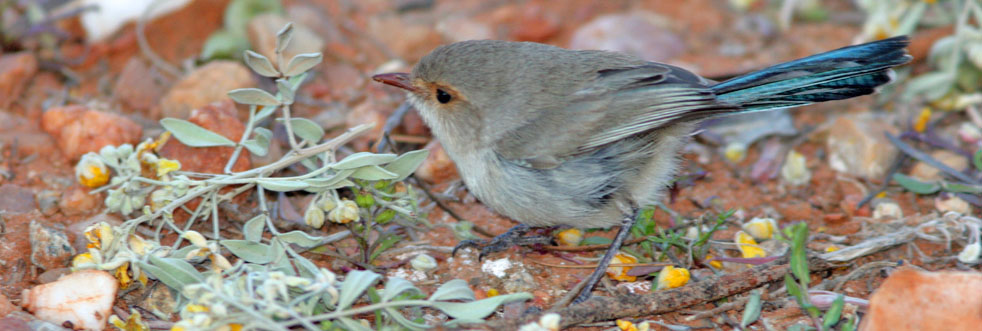

|
Among the 16 fairywrens, a dozen are in genus Malurus and ten of them are Australian endemics. Yet in New Guinea, there are six fairywrens in four different genera. All are quite fabulous. Wallace's Fairywren Sipodutus wallacii is an arboreal species of the lowlands which does not cock its tail, while Orange-crowned Fairywren Clytomyias insignis is a cock-tailed skulker restricted to high montane rain-forests. Both species are assigned to monotypic genera and both are scarce and local.
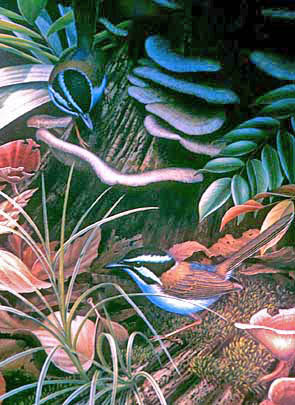 White-shouldered Malurus alboscapulatus is a grassland species in lowland and mid-montane elevations. While camped in a hut in the Vogelkop of Irian Jaya, we passed through a territory of a pair of these pied sprites daily enroute to the primary forest above the little village of Mokwam. Its Latin name emphasizes one unique feature of this family: a bare intrascapular patch of skin on the upper back that is not covered by a tract of feathers. Some species have evolved longer feathers on the sides of this bare spot which cover it in normal activity, but that can be raised in courtship to show a dramatic fluffy array of otherwise hidden feathers. The male Emperor Fairywren Malurus cyanocephalus is a beautiful cobalt blue, black-faced bird of lowland undergrowth (the striking females have red backs and white underparts); it is hard to spot but a treat when found. Like many fairywrens, is it often first located by its voice. White-shouldered Malurus alboscapulatus is a grassland species in lowland and mid-montane elevations. While camped in a hut in the Vogelkop of Irian Jaya, we passed through a territory of a pair of these pied sprites daily enroute to the primary forest above the little village of Mokwam. Its Latin name emphasizes one unique feature of this family: a bare intrascapular patch of skin on the upper back that is not covered by a tract of feathers. Some species have evolved longer feathers on the sides of this bare spot which cover it in normal activity, but that can be raised in courtship to show a dramatic fluffy array of otherwise hidden feathers. The male Emperor Fairywren Malurus cyanocephalus is a beautiful cobalt blue, black-faced bird of lowland undergrowth (the striking females have red backs and white underparts); it is hard to spot but a treat when found. Like many fairywrens, is it often first located by its voice.
The Broad-billed Fairywren Chenorhamphus grayi is another lowland skulker but it is particularly rare and local (no luck for me on this one). It was once thought to occur in two disjunct populations. The population on Mt. Bosavi in southeastern New Guinea was only discovered to science in 1980 when netted by Scottish bird-bander R.W. Campbell. This bird was first named as a new species, Campbell's Fairywren C. campbelli (Schodde & Weatherly 1983); Richard Weatherly's painting (in Schodde 1982) of a pair Campbell's Fairywren working around the base of a mushroom-laden jungle tree is one of my favorite compositions (a portion of this painting is at right; a photo doesn't really do justice to the art).
I wrote this paragraph in the year 2000: "In the late 1980s, I was at the American Museum of Natural History in New York doing research for my 'Cookilaria' petrel paper on a Chapman grant, and happened to visit the office of Mary LeCroy. She had on her desk a series of campbelli and grayi and was comparing each laboriously. She told me that she was coming to the conclusion that these taxa were best handled as subspecies of Broad-billed Fairywren. Ms. LeCroy was one of the primary ornithologists working on New Guinea birds at the time; her conclusion on this topic were published (LeCroy & Diamond 1995) and were followed by the majority of texts (e.g., Beehler et al. 1986, Coates 1990, Clements 1991) but not by all (e.g., Sibley & Monroe 1990). I still recall being struck by the differences — rather than the similarities — of Broad-billed versus Campbell's Fairywren. It will not surprise me to find it again split as a separate species in the future. Now to just see one!"
Update (2021): No, I've not yet seen either Broad-billed nor Campbell's Fairywrens. It looks like I never will. However, it does not come as a surprise that molecular evidence (Driskell et al. 2011) suggested that the two were better considered separate species after all. All three global checklists — IOC, eBird/Clements, and 4th ed. Howard & Moore checklists — adopted the split, as did recent New Guinea field guides (Pratt & Beehler 2015, Gregory 2017). Further, as Schodde (1982) had foreseen, both Broad-billed and Campbell's Fairywrens were genetically closer to Orange-crowned Fairywren Clytomyias insignis than to Malurus fairywrens, to which they had initially been assigned. Today, both are placed in genus Chenorhamphus, which was resurrected to include only them (Driskell et al. 2011). |
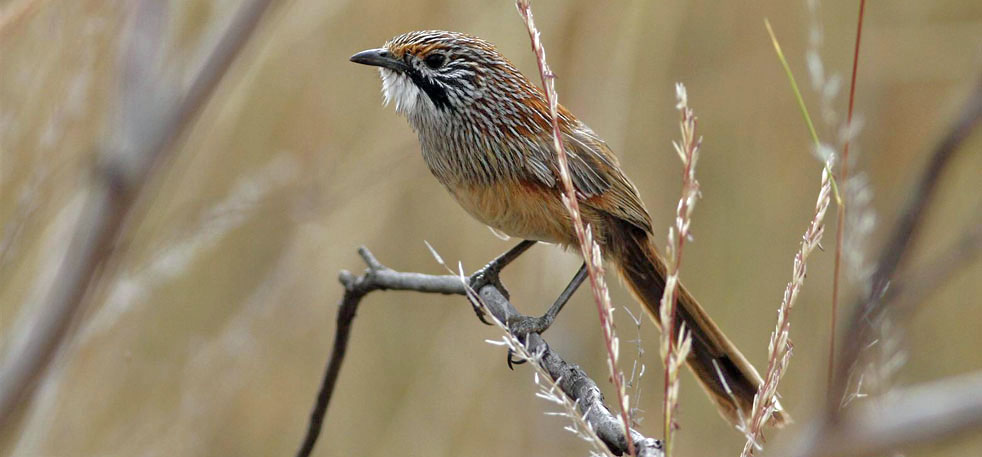 |
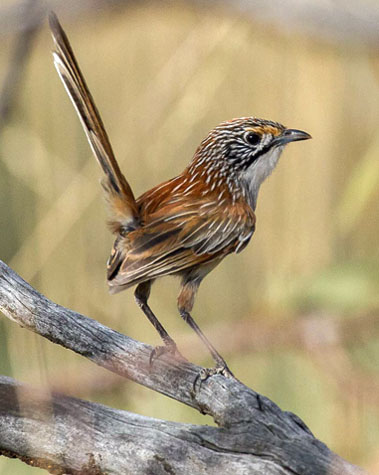 The remainder of this very interesting family is restricted to Australia. Among the Maluridae, perhaps no group is as elusive and fascinating as the grasswrens in genus Amytornis. Clad in often striking and complex patterns of black, white, gray or chestnut, each species is exceedingly difficult to locate in its preferred and often isolated habitats. When the initial version of this page was created in 2000, there were 8 species of grasswren in Australia. Today, most global and regional lists itemize up to 13 species (and sometimes even more). These are shy and sedentary skulkers and many populations are geographically isolated in arid country. The remainder of this very interesting family is restricted to Australia. Among the Maluridae, perhaps no group is as elusive and fascinating as the grasswrens in genus Amytornis. Clad in often striking and complex patterns of black, white, gray or chestnut, each species is exceedingly difficult to locate in its preferred and often isolated habitats. When the initial version of this page was created in 2000, there were 8 species of grasswren in Australia. Today, most global and regional lists itemize up to 13 species (and sometimes even more). These are shy and sedentary skulkers and many populations are geographically isolated in arid country.
A good "standard" grasswren is Striated Grasswren (above, in an excellent shot by Murray Lord). Like the majority of grasswrens, it is restricted to spiny hummocks of spinifex (Triodia) and can be exceptionally elusive to view as they creep through this low scrub. Once considered a comparatively widespread species in the arid interior, it has now been split into four generally-accepted species: the core Striated Grasswren (above) in the interior southeast, and then Short-tailed Grasswren A. merrotsyi in the Gawler & Flinders Ranges of South Australia, split a few years back (Schodde & Mason 1999). Recent new spits from Black et al. (2020) are Rufous Grasswren A. oweni, on isolated sand plains and sand-dunes in central-west interior (including A.o. whitei in the far northwest, sometimes also split), and Opalton Grasswren A. rowleyi, isolated in the Forsyth Range of Queensland. Murray Lord also took this great shot of Opalton Grasswren (left). The cocked-up tail is a standard malurid character. |
| 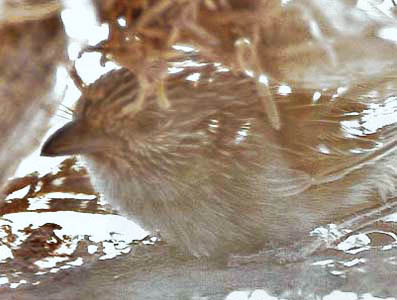 Not all grasswren are spinifex specialists. Norman & Christidis (2016) studied how two grasswren species responded "to new ecological opportunities arising from past climate change . . . as the result of increasing aridity over the past six million years." These were Western Grasswren A. textilis and Thick-billed Grasswren A. modestus. Neither species inhabit spinifex but use complexes of shrub understory. During the aridization of the Australian interior during the last 6 millions years, a new shrub community developed called the "." Both grasswren species expanded their ranges to include this new community. Later, "habitat specialisation (niche contraction) occurred in populations inhabiting chenopod shrubland communities in central Australia," and this niche contraction " is associated with divergence of A. modestus and A. t. myall." Not all grasswren are spinifex specialists. Norman & Christidis (2016) studied how two grasswren species responded "to new ecological opportunities arising from past climate change . . . as the result of increasing aridity over the past six million years." These were Western Grasswren A. textilis and Thick-billed Grasswren A. modestus. Neither species inhabit spinifex but use complexes of shrub understory. During the aridization of the Australian interior during the last 6 millions years, a new shrub community developed called the "." Both grasswren species expanded their ranges to include this new community. Later, "habitat specialisation (niche contraction) occurred in populations inhabiting chenopod shrubland communities in central Australia," and this niche contraction " is associated with divergence of A. modestus and A. t. myall."
Today, both these populations are specialists of chenopod shrubland. Thick-billed Grasswren now occurs as different subspecies in dense chenopod scrub dominated by black bluebush and old man saltbush with subspecies located in the Lake Eyre and Lake Frome drainages. This is about the most arid and hottest deserts of Australia's interior. This Thick-billed Grasswren (right) was physically panting in the heat in the Lake Eyre basin during the heat of the day.
In short, climate change and isolation, and the creating of new botanical communities, led to diversification in grasswren, which can lead to new subspecies and, over time, these may evolve into new species. Similar forces may have led to the speciation recognized by Schodde & Mason (1999) when they spit the Flinders Ranges race of the Striated out as Short-tailed Grasswren A. merrotsyi, and the Mt. Isa race of Dusky A. purnelli became Kalkadoon Grasswren A. ballarae.
|
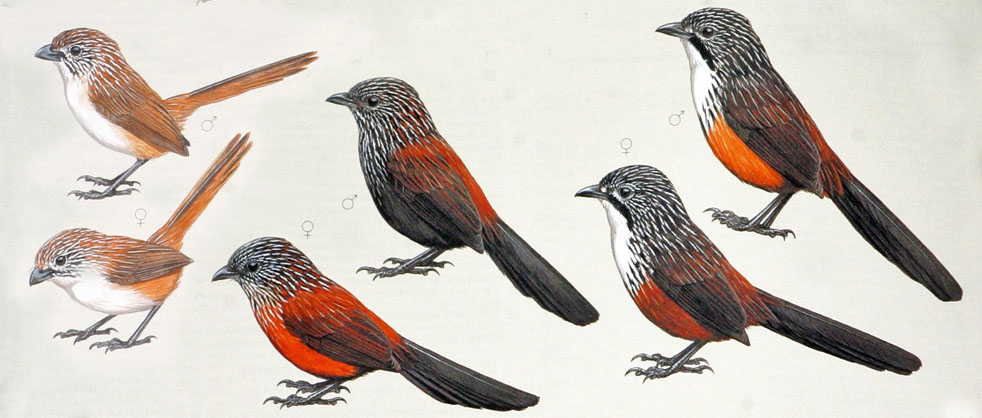 |
The Lake Eyre basin is home to the near-mythical Eyrean Grasswren A. goyderi (pair shown above left in the painting above). Until 1972, when its habitat [sandhill canegrass] was rediscovered and quantified, the Eyrean Grasswren was thought to be a very rare "lost species" as nothing had been heard of it for about a century. Even the attempt to locate such a grasswren was an expedition in itself. One must be prepared for long drives or hikes in rough country where a vehicle breakdown can be perilous. In the heat of the Australian summer in 2009, I joined an organized search for "five grasswren in five days," including Eyrean. We did have a well-equipped 4-wheel-drive and a "snorkel" to cross dry ravines that become flooded with unexpected rain (we actually needed to use the snorkel in that circumstance). We saw Eyrean Grasswren running on sand-dunes — and sometimes quite close — but each encounter was too brief for me to get off a photo. We also saw Thick-billed Grasswren in the equally remote saltbush flats of interior south Australia on this tour organized by Peter Waanders of South Australia.
Black Grasswren A. housei and White-throated Grasswren A. woodwardi (pairs shown center and right in the painting) are restricted to spinifex among wild, bouldery sandstone tablelands in the northwest and north of Australia, respectively. These are also remote regions that can take days and luck with the weather to reach. I view the search for the 13 Australian grasswrens as one of the great bird challenges of the world. I did see five of them in five days of focused search with a guide, but who knows if that opportunity will ever come again.
The final set of malurids are the three emuwrens with spiky tails (genus Stipiturus). These are tiny birds with extremely long tails that are more spindly than the tail of any of the fairywrens. Males in each of the three species have a bright, sky-blue throat. Two species reside in arid spinifex in the interior; the other on coastal heath of southern Australia. All are extremely shy and, like grasswrens, one most listen for their very thin, faint calls. This amazing shot of Rufous-crowned Emuwren is by Murray Lord in the interior of Queensland. |
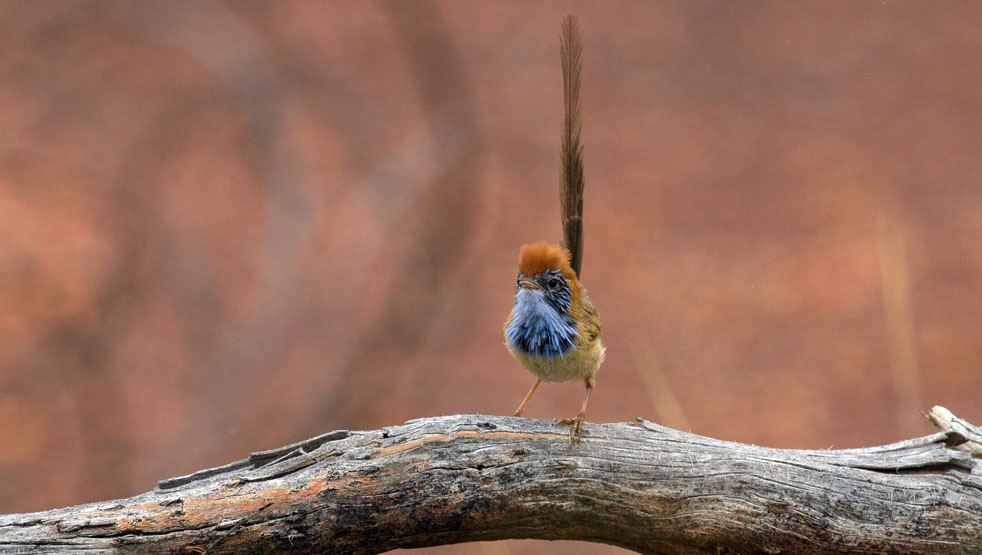 |
| |
Photos: The male Purple-backed Fairywren Malurus assimilis was at Burchin Creek, Flinders Range, South Australia, on 19 Nov 2009. The male White-winged Fairywren Malurus leucopterus was at the Alice Springs WTP, Northern Territory, Australia, on 18 Aug 2008. The pair of Blue-breasted Fairywren Malurus pulcherimmus was at Dryandra Forest Reserve, Western Australia, on 6 Aug 2008. Individual photos of a female and a male Splendid Fairywren Malurus splendens were taken at Simpsons Gap, West MacDonnell NP, Northern Territory, Australia, on 16 Aug 2008. The painting of Campbell's Fairywren Chenorhamphus campbelli is a part of a Richard Weatherly painting from Schodde (1982). Murray Lord took the photos of Striated Grasswren Amytornis striatus at Gluepot Reserve, South Australia, on 15 Oct 2012, and the photo of Opalton Grasswren Amytornis rowleyi near Opalton, Queensland, Australia, on 22 Mar 2021. The cowering Thick-billed Grasswren Malurus modestus was at Lyndhusrt, in the Eyrean Basin of northern South Australia, on 19 Nov 2009. The painting of Eyrean Grasswren Amytornis goyderi, Black A. housei, and White-throated Grasswren A. woodwardi is a photo of a portion of plate 43, by artist Hilary Burn, in Rowley & Russell (2007), somewhat rearranged. Murray Lord took the stunning shot of Rufous-crowned Emuwren Stipiturus ruficeps near Opalton, Queensland, Australia, on 23 Mar 2021.
All photos © Don Roberson;, except those three attributed © Murray Lord, and used with permission; all rights reserved.
Family book: Rating 
Schodde, Richard. 1982. The Fairy-Wrens: A Monograph of the Maluridae. Illustrated by Richard Weatherly. Lansdowne Editions, Melbourne, Australia.
 In my opinion this is the greatest "family book" ever published. Now out-of-print and difficult to locate (but still available in the fine used book trade), it includes virtually everything I desire in this genre. It is not very thick but the format is oversize (11 x 14") which permits reproduction of absolutely gorgeous full-page paintings for each species by Richard Weatherly. Mostly pairs are shown (thus sexual dimorphism is well illustrated) but occasional the view is of a family group or a lone bird. Behavior is often highlighted — I just adore the bathing White-winged Fairywren (M. leucopterus) "in small pool on Dirk Hartog Island, Western Australia." That quote is from the caption for the art — each painting illustrates some specific native habitat; one feels that "you are there" watching that very bird. The artist's line sketches are liberally scattered throughout the text, further illustrating habitat, ecology, and behavior. Just incredible art! Let field guides do field guide art — a family book should engage the reader rather than present yet another dreary set of static field guide plates and lengthy, unreadable details of plumage written from long-dead specimens. As much as I could go on and on about the full-page & full habitat paintings, the text is equal to the art. Written by an expert on the Maluridae, it has all the details of plumages, voice and distribution (on maps within the species' text — not somewhere else in the book) that one expects, but all are written in a breezy, engaging tone and, although including information at the state-of-the-science in 1982, structured with words that a lay person can understand. The text is full of information about behavior, breeding, displays and subspecies. And, best of all, each species account begins with the story of this bird's discovery to science. What a joy to read! And the introduction is full of stories and a fine overview of the family. Great art, great writing, authoritative information! It doesn't get any better than this. In my opinion this is the greatest "family book" ever published. Now out-of-print and difficult to locate (but still available in the fine used book trade), it includes virtually everything I desire in this genre. It is not very thick but the format is oversize (11 x 14") which permits reproduction of absolutely gorgeous full-page paintings for each species by Richard Weatherly. Mostly pairs are shown (thus sexual dimorphism is well illustrated) but occasional the view is of a family group or a lone bird. Behavior is often highlighted — I just adore the bathing White-winged Fairywren (M. leucopterus) "in small pool on Dirk Hartog Island, Western Australia." That quote is from the caption for the art — each painting illustrates some specific native habitat; one feels that "you are there" watching that very bird. The artist's line sketches are liberally scattered throughout the text, further illustrating habitat, ecology, and behavior. Just incredible art! Let field guides do field guide art — a family book should engage the reader rather than present yet another dreary set of static field guide plates and lengthy, unreadable details of plumage written from long-dead specimens. As much as I could go on and on about the full-page & full habitat paintings, the text is equal to the art. Written by an expert on the Maluridae, it has all the details of plumages, voice and distribution (on maps within the species' text — not somewhere else in the book) that one expects, but all are written in a breezy, engaging tone and, although including information at the state-of-the-science in 1982, structured with words that a lay person can understand. The text is full of information about behavior, breeding, displays and subspecies. And, best of all, each species account begins with the story of this bird's discovery to science. What a joy to read! And the introduction is full of stories and a fine overview of the family. Great art, great writing, authoritative information! It doesn't get any better than this.
I know there is a more recent family book (Rowley & Russell 1997) in the solid Oxford Univ. Press series. If it is like others in that series, it is very good. The senior author, Ian Rowley, is one of the top world experts on fairywrens. I have not seen this new book. Its smaller format (a shorter but thicker book) will mean the art cannot compare with Weatherly's collection, but I would expect the text to be excellent. In addition, the Handbook of the Birds of the World chapter (Rowley & Russell 2007) is excellent. The Australian literature that includes this family is extensive. Frith (1979) has very nice photos of Australian malurids as does Coates (1990) for New Guinea species.
Half-a family book: Rating 
Andrew Black and Peter Gower. 2017. Grasswrens: Australian Outback Identities. Axiom Publishing, Adelaide, Australia.
Guest review:
While not covering the whole fairywren family, this book focuses on the species many birders find the most interesting. The lead author has been heavily involved in grasswren research in recent years and so it contains a an up to date summary of knowledge as at its publication date. General chapters include history of the discovery of grasswren species, their habitats, social organisation, voice, breeding and conservation status. It is accompanied by chapters on each species which often discuss in detail the confused history of grasswren taxonomy and looks at evidence about species distribution before wide scale human changes to habitats. The book is extensively illustrated with top quality photographs by the second author and others, as well as many photos of habitat that are very useful when you are in the field seeking the birds. The book would have had a relatively small print run; it is still available from Andrew Isles bookshop. — Murray Lord
Literature cited:
Beehler, B. M., T. K. Pratt, and D. A. Zimmerman. 1986. Birds of New Guinea. Princeton Univ. Press, Princeton, N.J.
Black, A., G. Dolman, C.A. Wilson, C.D. Campbell, L. Pedler, and L. Joseph. 2020. A taxonomic revision of the Striated Grasswren Amytornis striatus complex (Aves: Maluridae) after analysis of phylogenetic and phenotypic data. Emu - Austral Orn. 120: 191–200.
Christidis, L., F.E. Rheindt, W.E. Boles, and J A. Norman. 2013. A re-appraisal of species diversity within the Australian grasswrens Amytornis (Aves: Maluridae). Australian Zool. 36: 429–437.
Clements, J. F. 1991. Birds of the World: A Checklist. 4th ed. Ibis Publ., Vista, CA.
Coates, B. J. 1990. The Birds of Papua New Guinea. Part II. Dove Publ., Ltd., Alderley, Australia.
Driskell, A.C., J.A. Norman, S. Pruett-Jones, E. Mangall, S. Sonsthagen, and L. Christidis. 2011. A multigene phylogeny examining evolutionary and ecological relationships in the Australo-Papuan wrens of the subfamily Malurinae (Aves). Molec. Phylog. Evol. 60: 480–485.
Frith, H. J., consulting ed. 1979. The Reader's Digest Complete Book of Australian Birds. 2d rev. ed. Reader's Digest, Ltd., Sydney.
Gregory, P. 2017. Birds of New Guinea, including Bismarck Archipelago and Bougainville. Lynx Edicions, Barcelona, Spain.
LeCroy, M., and J. Diamond. 1995. Plumage variation in the Broad-billed Fairy-wren Malurus grayi. Emu 95: 185–193.
Norman, J.,and L. Christidis, L. 2016. Ecological opportunity and the evolution of habitat preferences in an arid-zone bird: implications for speciation in a climate-modified landscape. Sci Rep 6: 19613; https://doi.org/10.1038/srep19613
Pratt, T.K., and B.M. Beehler. 2015. Birds of New Guinea. 2d ed. Princeton University Press, Princeton, New Jersey.
Rowley, I. 1965. The life history of the Superb Blue Wren Malurus cyaneus. Emu 64: 251–297.
Rowley, I., and E. Russell. 1997. Fairy-Wrens and Grasswrens: Maluridae. Oxford Univ. Press, Oxford.
Rowley, I., and E. Russell. 2007. Family Maluridae (Fairy-wrens), pp. 490–531 in Handbook of the Birds of the World (del Hoyo, J., A. Elliott & D.A. Christie, eds). Vol. 12. Lynx Edicions, Barcelona, Spain.
Schodde, R., and I. J. Mason. 1999. The Directory of Australian Birds, Passerines. CSIRO Publishing.
Schodde, R., and R. G. Weatherly. 1983. Contributions to Papuasian ornithology, 8: Campbell's Fairy-wren (Malurus campbelli), a new species from New Guinea. Emu 82: 308-309.
Sibley, C. G., and B. L. Monroe, Jr. 1990. Distribution and Taxonomy of the Birds of the World. Yale Univ. Press, New Haven, CT.
|
|
|





 The Maluridae is an Australasian family comprised of 16 fairywrens, three emu-wrens, and 13 grasswrens. Each of of them is an absolutely fabulous little bird. They are generally active, cock-tailed, territorial, non-migratory foliage-gleaning "wrens;" many have brilliant plumage patterns. [They are not closely related to Holarctic wrens at all]. Six species are malurids are found only in New Guinea and adjacent islands, but 26 are restricted to Australia. The family is named after the fairywren genus Malurus, and fairywrens are the most colorful group in the family.
The Maluridae is an Australasian family comprised of 16 fairywrens, three emu-wrens, and 13 grasswrens. Each of of them is an absolutely fabulous little bird. They are generally active, cock-tailed, territorial, non-migratory foliage-gleaning "wrens;" many have brilliant plumage patterns. [They are not closely related to Holarctic wrens at all]. Six species are malurids are found only in New Guinea and adjacent islands, but 26 are restricted to Australia. The family is named after the fairywren genus Malurus, and fairywrens are the most colorful group in the family.  Strong sexual dimorphism is a common feature among the Malurus fairywrens, such as Blue-breasted Fairywren (right; female & male together). This is a species of southwest and southern Australia, living in the understory of eucalypt woodland or adjacent heath.
Strong sexual dimorphism is a common feature among the Malurus fairywrens, such as Blue-breasted Fairywren (right; female & male together). This is a species of southwest and southern Australia, living in the understory of eucalypt woodland or adjacent heath.

 White-shouldered Malurus alboscapulatus is a grassland species in lowland and mid-montane elevations. While camped in a hut in the Vogelkop of Irian Jaya, we passed through a territory of a pair of these pied sprites daily enroute to the primary forest above the little village of Mokwam. Its Latin name emphasizes one unique feature of this family: a bare intrascapular patch of skin on the upper back that is not covered by a tract of feathers. Some species have evolved longer feathers on the sides of this bare spot which cover it in normal activity, but that can be raised in courtship to show a dramatic fluffy array of otherwise hidden feathers. The male Emperor Fairywren Malurus cyanocephalus is a beautiful cobalt blue, black-faced bird of lowland undergrowth (the striking females have red backs and white underparts); it is hard to spot but a treat when found. Like many fairywrens, is it often first located by its voice.
White-shouldered Malurus alboscapulatus is a grassland species in lowland and mid-montane elevations. While camped in a hut in the Vogelkop of Irian Jaya, we passed through a territory of a pair of these pied sprites daily enroute to the primary forest above the little village of Mokwam. Its Latin name emphasizes one unique feature of this family: a bare intrascapular patch of skin on the upper back that is not covered by a tract of feathers. Some species have evolved longer feathers on the sides of this bare spot which cover it in normal activity, but that can be raised in courtship to show a dramatic fluffy array of otherwise hidden feathers. The male Emperor Fairywren Malurus cyanocephalus is a beautiful cobalt blue, black-faced bird of lowland undergrowth (the striking females have red backs and white underparts); it is hard to spot but a treat when found. Like many fairywrens, is it often first located by its voice.  The remainder of this very interesting family is restricted to Australia. Among the Maluridae, perhaps no group is as elusive and fascinating as the grasswrens in genus Amytornis. Clad in often striking and complex patterns of black, white, gray or chestnut, each species is exceedingly difficult to locate in its preferred and often isolated habitats. When the initial version of this page was created in 2000, there were 8 species of grasswren in Australia. Today, most global and regional lists itemize up to 13 species (and sometimes even more). These are shy and sedentary skulkers and many populations are geographically isolated in arid country.
The remainder of this very interesting family is restricted to Australia. Among the Maluridae, perhaps no group is as elusive and fascinating as the grasswrens in genus Amytornis. Clad in often striking and complex patterns of black, white, gray or chestnut, each species is exceedingly difficult to locate in its preferred and often isolated habitats. When the initial version of this page was created in 2000, there were 8 species of grasswren in Australia. Today, most global and regional lists itemize up to 13 species (and sometimes even more). These are shy and sedentary skulkers and many populations are geographically isolated in arid country.  Not all grasswren are spinifex specialists. Norman & Christidis (2016) studied how two grasswren species responded "to new ecological opportunities arising from past climate change . . . as the result of increasing aridity over the past six million years." These were Western Grasswren A. textilis and Thick-billed Grasswren A. modestus. Neither species inhabit spinifex but use complexes of shrub understory. During the aridization of the Australian interior during the last 6 millions years, a new shrub community developed called the "." Both grasswren species expanded their ranges to include this new community. Later, "habitat specialisation (niche contraction) occurred in populations inhabiting chenopod shrubland communities in central Australia," and this niche contraction " is associated with divergence of A. modestus and A. t. myall."
Not all grasswren are spinifex specialists. Norman & Christidis (2016) studied how two grasswren species responded "to new ecological opportunities arising from past climate change . . . as the result of increasing aridity over the past six million years." These were Western Grasswren A. textilis and Thick-billed Grasswren A. modestus. Neither species inhabit spinifex but use complexes of shrub understory. During the aridization of the Australian interior during the last 6 millions years, a new shrub community developed called the "." Both grasswren species expanded their ranges to include this new community. Later, "habitat specialisation (niche contraction) occurred in populations inhabiting chenopod shrubland communities in central Australia," and this niche contraction " is associated with divergence of A. modestus and A. t. myall." 
 In my opinion this is the greatest "family book" ever published. Now out-of-print and difficult to locate (but still available in the fine used book trade), it includes virtually everything I desire in this genre. It is not very thick but the format is oversize (11 x 14") which permits reproduction of absolutely gorgeous full-page paintings for each species by Richard Weatherly. Mostly pairs are shown (thus sexual dimorphism is well illustrated) but occasional the view is of a family group or a lone bird. Behavior is often highlighted — I just adore the bathing White-winged Fairywren (M. leucopterus) "in small pool on Dirk Hartog Island, Western Australia." That quote is from the caption for the art — each painting illustrates some specific native habitat; one feels that "you are there" watching that very bird. The artist's line sketches are liberally scattered throughout the text, further illustrating habitat, ecology, and behavior. Just incredible art! Let field guides do field guide art — a family book should engage the reader rather than present yet another dreary set of static field guide plates and lengthy, unreadable details of plumage written from long-dead specimens. As much as I could go on and on about the full-page & full habitat paintings, the text is equal to the art. Written by an expert on the Maluridae, it has all the details of plumages, voice and distribution (on maps within the species' text — not somewhere else in the book) that one expects, but all are written in a breezy, engaging tone and, although including information at the state-of-the-science in 1982, structured with words that a lay person can understand. The text is full of information about behavior, breeding, displays and subspecies. And, best of all, each species account begins with the story of this bird's discovery to science. What a joy to read! And the introduction is full of stories and a fine overview of the family. Great art, great writing, authoritative information! It doesn't get any better than this.
In my opinion this is the greatest "family book" ever published. Now out-of-print and difficult to locate (but still available in the fine used book trade), it includes virtually everything I desire in this genre. It is not very thick but the format is oversize (11 x 14") which permits reproduction of absolutely gorgeous full-page paintings for each species by Richard Weatherly. Mostly pairs are shown (thus sexual dimorphism is well illustrated) but occasional the view is of a family group or a lone bird. Behavior is often highlighted — I just adore the bathing White-winged Fairywren (M. leucopterus) "in small pool on Dirk Hartog Island, Western Australia." That quote is from the caption for the art — each painting illustrates some specific native habitat; one feels that "you are there" watching that very bird. The artist's line sketches are liberally scattered throughout the text, further illustrating habitat, ecology, and behavior. Just incredible art! Let field guides do field guide art — a family book should engage the reader rather than present yet another dreary set of static field guide plates and lengthy, unreadable details of plumage written from long-dead specimens. As much as I could go on and on about the full-page & full habitat paintings, the text is equal to the art. Written by an expert on the Maluridae, it has all the details of plumages, voice and distribution (on maps within the species' text — not somewhere else in the book) that one expects, but all are written in a breezy, engaging tone and, although including information at the state-of-the-science in 1982, structured with words that a lay person can understand. The text is full of information about behavior, breeding, displays and subspecies. And, best of all, each species account begins with the story of this bird's discovery to science. What a joy to read! And the introduction is full of stories and a fine overview of the family. Great art, great writing, authoritative information! It doesn't get any better than this.